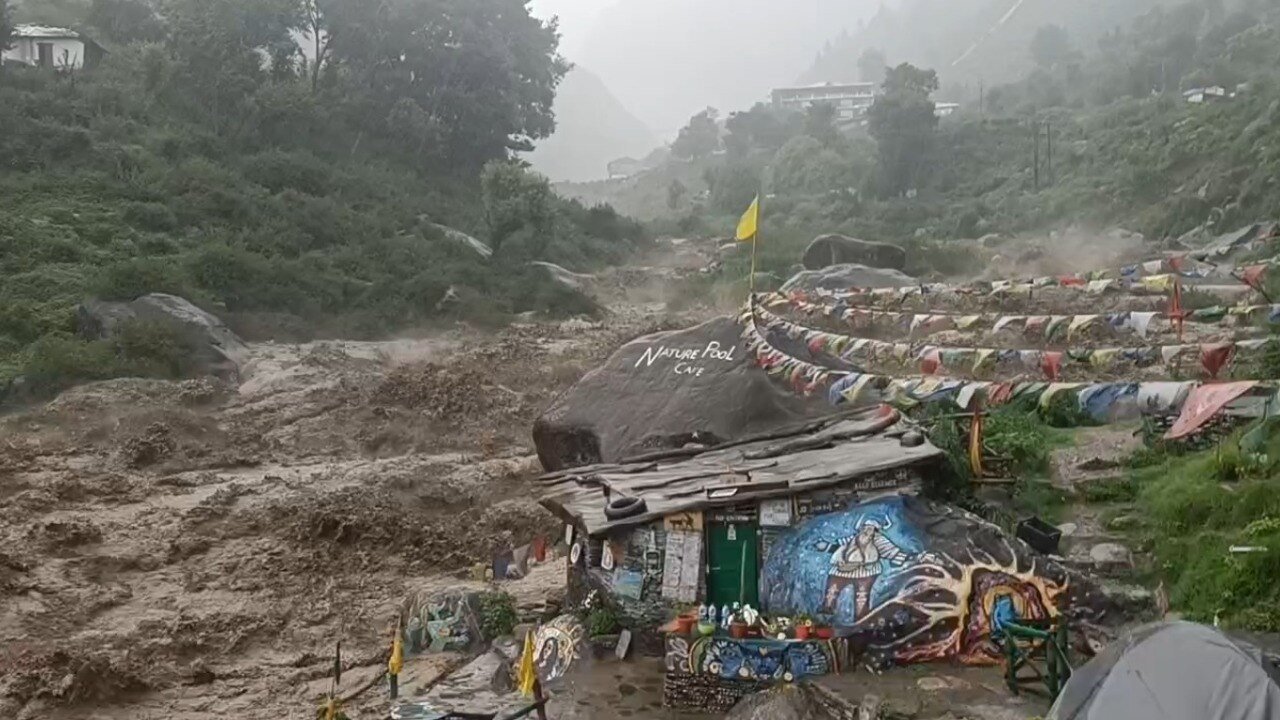2 Dead, 11 Missing as Cloudburst Devastates Himachal's Sainj Valley - Over 2,000 Tourists Stranded

A devastating cloudburst struck Himachal Pradesh's Sainj Valley in Kullu district yesterday, June 25, 2025, creating a rapidly evolving disaster situation that has left multiple people missing and thousands of tourists stranded. The incident has once again highlighted the vulnerable position of this Himalayan state in the face of extreme weather events.
The disaster was not limited to a single location but involved cloudbursts at five separate locations in Kullu and Kangra districts that wreaked havoc across Himachal Pradesh on Wednesday. Three cloudbursts incidents were reported from Jeeva Nallah and Rehla Bihal in Sainj and Shilagarh in Gadsa area of Kullu, while additional incidents occurred in Kangra district.
This widespread nature of the disaster has stretched emergency response resources and complicated rescue operations. Flash floods were also reported from Manali and Banjar in the district, requiring coordinated search operations across multiple locations simultaneously.
The disaster has resulted in a significant human toll with two people dead, 11 missing and over 2,000 tourists stranded according to the most recent reports. The casualty figures have varied across different sources, with some reports indicating 2 dead, 20 swept away in floods and others mentioning at least two people were killed and over a dozen are feared missing.
In the Sainj Valley specifically, three persons went missing after cloudbursts in the areas of Banjar sub-division — Sainj valley — in Kullu, with three people in Rehla Bihal trying to take away their valuables from their homes were washed away in the deluge and are missing. Additionally, eight labourers missing in Kangra have been reported from other affected areas.
The search and rescue operations are currently underway, with different teams of the State Disaster Response Authority (SDRF) engaged in the rescue operation. Emergency response teams are working against time to locate the missing individuals while dealing with challenging terrain and weather conditions.
The power sector has been particularly hard hit, with multiple hydroelectric projects in the area suffering damage. This follows a concerning pattern from previous years, where similar extreme weather events have repeatedly targeted the state's energy infrastructure, which is crucial for both local communities and the broader regional power grid.
The impact on tourism has been severe, with more than 150 tourist vehicles stranded in Shanshar, Shangarh and Suchaihan Panchayat areas of Sainj Valley, in which an estimated more than 2,000 tourists are aboard. The road cut near Siund has blocked the way out of the area, effectively trapping tourists in the affected region.
About 25 tourists are also feared to be stranded in Lahaul, adding to the humanitarian crisis. The timing of the cloudburst during the peak summer tourist season has created an additional layer of complexity to the disaster response, as thousands of tourists who had traveled to escape the summer heat now find themselves in a dangerous situation.
Local authorities are working to establish alternative routes and communication channels to reach the stranded tourists. Emergency shelters are being set up in safer locations, and efforts are being made to provide basic amenities including food, water, and medical assistance to those affected.
The Indian Meteorological Department (IMD) had issued warnings about the possibility of extreme weather in the region. According to a press release by the Indian Meteorological Department (IMD), isolated heavy rainfall is likely over Punjab, Haryana, Himachal Pradesh, Uttarakhand, and West Uttar Pradesh from June 25 to July 1. This forecast suggests that the current crisis may be part of a broader weather system that could affect multiple states in northern India over the coming days.
The prediction of continued heavy rainfall raises concerns about the possibility of additional cloudbursts and flash floods in the region. Authorities are maintaining high alert status and have advised residents and tourists in vulnerable areas to exercise extreme caution.
Authorities issued immediate alerts for surrounding areas following the cloudburst, demonstrating the activation of the state's disaster response protocols. Emergency response teams, including personnel from the National Disaster Response Force (NDRF) and local rescue units, have been deployed to the affected areas.
The District Emergency Operation Centre in Kullu is coordinating the rescue and relief efforts, maintaining communication with various agencies involved in the operation. Helicopter services are being considered for evacuation purposes, though weather conditions will determine the feasibility of such operations.
The cloudburst has caused significant damage to local infrastructure beyond the power projects. Roads connecting various villages in the Sainj Valley have been washed away or rendered impassable, effectively cutting off several communities from the outside world. This isolation makes it difficult to assess the full extent of damage and casualties in remote areas.
Communication networks have also been disrupted, hampering coordination efforts and making it challenging for families to contact their relatives who may be in the affected areas. Restoration of communication infrastructure is being prioritized to facilitate rescue operations and provide updates to concerned families.
This latest incident adds to the growing list of natural disasters that have plagued Himachal Pradesh in recent years. The state has witnessed a disturbing pattern of increasing frequency and intensity of extreme weather events, from the devastating 2023 floods to various cloudbursts and landslides that have occurred since then.
The recurring nature of these disasters raises serious questions about long-term preparedness and the need for more robust early warning systems. While the state has developed response mechanisms, the frequency of these events suggests that more proactive measures may be necessary to protect vulnerable communities and critical infrastructure.
The Sainj Valley, known for its pristine natural beauty and trekking routes, is a significant contributor to Himachal Pradesh's tourism economy. The current disaster not only affects immediate tourist safety but also poses long-term challenges for the tourism industry in the region.
The repeated occurrence of such disasters during peak tourist seasons creates a perception of risk that could deter future visitors. This has broader economic implications for local communities that depend heavily on tourism-related activities for their livelihoods.
With the IMD forecast indicating the possibility of continued heavy rainfall through July 1, authorities remain on high alert for additional weather-related emergencies. The extended period of predicted heavy rainfall increases the risk of more cloudbursts, landslides, and flash floods across the region.
Emergency preparedness measures are being strengthened, with additional rescue teams being kept on standby and evacuation plans being reviewed for other vulnerable areas. The focus is on minimizing casualties and ensuring swift response to any new incidents that may occur.
The latest cloudburst in Sainj Valley serves as another stark reminder of Himachal Pradesh's vulnerability to extreme weather events. As climate change continues to intensify weather patterns, the state needs to invest more heavily in early warning systems, disaster-resilient infrastructure, and community preparedness programs.
The recurring nature of these disasters also highlights the need for tourists and residents to stay informed about weather conditions and heed official warnings. Better coordination between meteorological agencies, disaster management authorities, and local communities is essential for reducing the impact of future extreme weather events.
As rescue and relief operations continue in Sainj Valley, the immediate priority remains saving lives and providing assistance to those affected. However, this latest incident underscores the urgent need for comprehensive long-term strategies to build resilience against the increasing frequency of natural disasters in this vulnerable Himalayan region.
The disaster was not limited to a single location but involved cloudbursts at five separate locations in Kullu and Kangra districts that wreaked havoc across Himachal Pradesh on Wednesday. Three cloudbursts incidents were reported from Jeeva Nallah and Rehla Bihal in Sainj and Shilagarh in Gadsa area of Kullu, while additional incidents occurred in Kangra district.
This widespread nature of the disaster has stretched emergency response resources and complicated rescue operations. Flash floods were also reported from Manali and Banjar in the district, requiring coordinated search operations across multiple locations simultaneously.
The disaster has resulted in a significant human toll with two people dead, 11 missing and over 2,000 tourists stranded according to the most recent reports. The casualty figures have varied across different sources, with some reports indicating 2 dead, 20 swept away in floods and others mentioning at least two people were killed and over a dozen are feared missing.
In the Sainj Valley specifically, three persons went missing after cloudbursts in the areas of Banjar sub-division — Sainj valley — in Kullu, with three people in Rehla Bihal trying to take away their valuables from their homes were washed away in the deluge and are missing. Additionally, eight labourers missing in Kangra have been reported from other affected areas.
The search and rescue operations are currently underway, with different teams of the State Disaster Response Authority (SDRF) engaged in the rescue operation. Emergency response teams are working against time to locate the missing individuals while dealing with challenging terrain and weather conditions.
The power sector has been particularly hard hit, with multiple hydroelectric projects in the area suffering damage. This follows a concerning pattern from previous years, where similar extreme weather events have repeatedly targeted the state's energy infrastructure, which is crucial for both local communities and the broader regional power grid.
The impact on tourism has been severe, with more than 150 tourist vehicles stranded in Shanshar, Shangarh and Suchaihan Panchayat areas of Sainj Valley, in which an estimated more than 2,000 tourists are aboard. The road cut near Siund has blocked the way out of the area, effectively trapping tourists in the affected region.
About 25 tourists are also feared to be stranded in Lahaul, adding to the humanitarian crisis. The timing of the cloudburst during the peak summer tourist season has created an additional layer of complexity to the disaster response, as thousands of tourists who had traveled to escape the summer heat now find themselves in a dangerous situation.
Local authorities are working to establish alternative routes and communication channels to reach the stranded tourists. Emergency shelters are being set up in safer locations, and efforts are being made to provide basic amenities including food, water, and medical assistance to those affected.
The Indian Meteorological Department (IMD) had issued warnings about the possibility of extreme weather in the region. According to a press release by the Indian Meteorological Department (IMD), isolated heavy rainfall is likely over Punjab, Haryana, Himachal Pradesh, Uttarakhand, and West Uttar Pradesh from June 25 to July 1. This forecast suggests that the current crisis may be part of a broader weather system that could affect multiple states in northern India over the coming days.
The prediction of continued heavy rainfall raises concerns about the possibility of additional cloudbursts and flash floods in the region. Authorities are maintaining high alert status and have advised residents and tourists in vulnerable areas to exercise extreme caution.
Authorities issued immediate alerts for surrounding areas following the cloudburst, demonstrating the activation of the state's disaster response protocols. Emergency response teams, including personnel from the National Disaster Response Force (NDRF) and local rescue units, have been deployed to the affected areas.
The District Emergency Operation Centre in Kullu is coordinating the rescue and relief efforts, maintaining communication with various agencies involved in the operation. Helicopter services are being considered for evacuation purposes, though weather conditions will determine the feasibility of such operations.
The cloudburst has caused significant damage to local infrastructure beyond the power projects. Roads connecting various villages in the Sainj Valley have been washed away or rendered impassable, effectively cutting off several communities from the outside world. This isolation makes it difficult to assess the full extent of damage and casualties in remote areas.
Communication networks have also been disrupted, hampering coordination efforts and making it challenging for families to contact their relatives who may be in the affected areas. Restoration of communication infrastructure is being prioritized to facilitate rescue operations and provide updates to concerned families.
This latest incident adds to the growing list of natural disasters that have plagued Himachal Pradesh in recent years. The state has witnessed a disturbing pattern of increasing frequency and intensity of extreme weather events, from the devastating 2023 floods to various cloudbursts and landslides that have occurred since then.
The recurring nature of these disasters raises serious questions about long-term preparedness and the need for more robust early warning systems. While the state has developed response mechanisms, the frequency of these events suggests that more proactive measures may be necessary to protect vulnerable communities and critical infrastructure.
The Sainj Valley, known for its pristine natural beauty and trekking routes, is a significant contributor to Himachal Pradesh's tourism economy. The current disaster not only affects immediate tourist safety but also poses long-term challenges for the tourism industry in the region.
The repeated occurrence of such disasters during peak tourist seasons creates a perception of risk that could deter future visitors. This has broader economic implications for local communities that depend heavily on tourism-related activities for their livelihoods.
With the IMD forecast indicating the possibility of continued heavy rainfall through July 1, authorities remain on high alert for additional weather-related emergencies. The extended period of predicted heavy rainfall increases the risk of more cloudbursts, landslides, and flash floods across the region.
Emergency preparedness measures are being strengthened, with additional rescue teams being kept on standby and evacuation plans being reviewed for other vulnerable areas. The focus is on minimizing casualties and ensuring swift response to any new incidents that may occur.
The latest cloudburst in Sainj Valley serves as another stark reminder of Himachal Pradesh's vulnerability to extreme weather events. As climate change continues to intensify weather patterns, the state needs to invest more heavily in early warning systems, disaster-resilient infrastructure, and community preparedness programs.
The recurring nature of these disasters also highlights the need for tourists and residents to stay informed about weather conditions and heed official warnings. Better coordination between meteorological agencies, disaster management authorities, and local communities is essential for reducing the impact of future extreme weather events.
As rescue and relief operations continue in Sainj Valley, the immediate priority remains saving lives and providing assistance to those affected. However, this latest incident underscores the urgent need for comprehensive long-term strategies to build resilience against the increasing frequency of natural disasters in this vulnerable Himalayan region.







